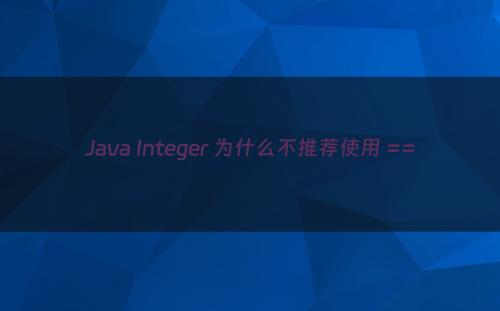所有整型包装类对象之间的比较全部使用equals方法比较。
对于 Integer var = ? 在 -128 至 127 范围内的赋值,Integer对象是在IntegerCache.cache产生,会复用已有对象,这个区间内的Integer值可以直接使用 == 进行判断,但是这个区间之外的所有数据,都会在堆上产生,并不会复用已有对象,所以推荐使用equals方法进行判断。

举个栗子:
public static void main(String[] args) {
Integer a = 100,
b = 100,
c = 200,
d = 200;
System.out.println(a == b);
System.out.println(c == d);
}
输出结果:
/**
* Returns an {@code Integer} instance representing the specified
* {@code int} value. If a new {@code Integer} instance is not
* required, this method should generally be used in preference to
* the constructor {@link #Integer(int)}, as this method is likely
* to yield significantly better space and time performance by
* caching frequently requested values.
*
* This method will always cache values in the range -128 to 127,
* inclusive, and may cache other values outside of this range.
*
* @param i an {@code int} value.
* @return an {@code Integer} instance representing {@code i}.
* @since 1.5
*/
public static Integer valueOf(int i) {
assert IntegerCache.high >= 127;
if (i >= IntegerCache.low && i <= IntegerCache.high)
return IntegerCache.cache[i + (-IntegerCache.low)];
return new Integer(i);
}
如果 i 的值大于 -128 , 小于 127的时候,就会在IntegerCache.cache中直接获取,如果不是这个区间范围里面的值,就直接 new了,也就是新对象,使用 == 肯定不同了。
我们接着看一下 IntegerCache.cache 是个什么东东。
/**
* Cache to support the object identity semantics of autoboxing for values between
* -128 and 127 (inclusive) as required by JLS.
*
* The cache is initialized on first usage. The size of the cache
* may be controlled by the -XX:AutoBoxCacheMax=<size> option.
* During VM initialization, java.lang.Integer.IntegerCache.high property
* may be set and saved in the private system properties in the
* sun.misc.VM class.
*/
private static class IntegerCache {
static final int low = -128;
static final int high;
static final Integer cache[];
static {
// high value may be configured by property
int h = 127;
String integerCacheHighPropValue =
sun.misc.VM.getSavedProperty("java.lang.Integer.IntegerCache.high");
if (integerCacheHighPropValue != null) {
int i = parseInt(integerCacheHighPropValue);
i = Math.max(i, 127);
// Maximum array size is Integer.MAX_VALUE
h = Math.min(i, Integer.MAX_VALUE - (-low) -1);
}
high = h;
cache = new Integer[(high - low) + 1];
int j = low;
for(int k = 0; k < cache.length; k++)
cache[k] = new Integer(j++);
}
private IntegerCache() {}
}
从注释中,我们可以看出,这是个缓存对象,用来提高访问速度。可以使用-XX:AutoBoxCacheMax=<size> 来控制缓存的大小,
这我们就明白了,如果设置 -XX:AutoBoxCacheMax=200。那上面的两个输出就都是true了。
我就不验证了,有兴趣的小伙伴可以验证一下。但是我还是建议大家,乖乖的使用equals方法来进行判断吧。
